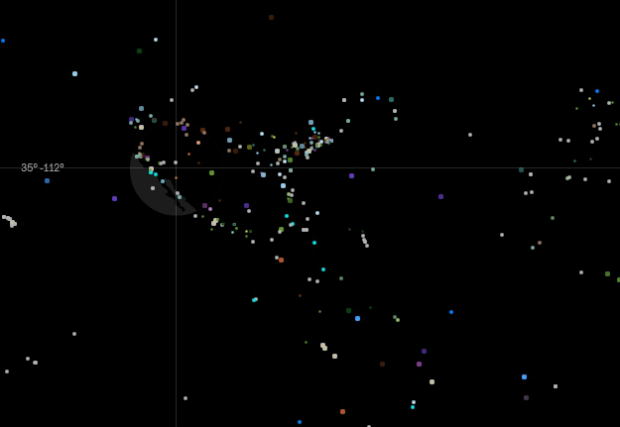What is Missing? by Maya Lin seeks to raise awareness about the mass extinction of species. It has a beautiful interface. The world map is black on a sea of black. Your mouse acts as a sort of flashlight layered between land and water, showing you glimpses of familiar coastlines and allowing you to select dots that tell the stories of extinction.
We are experiencing the sixth mass extinction in the planet’s history, and the only one to be caused not by a catastrophic event, but by the actions of a single species – mankind. On average, every 20 minutes a distinct living species of plant or animal disappears. At this rate, by some estimates, as much as 30 percent of the world’s animals and plants could be on a path to extinction in 100 years.
The site states that the dots on the world map each represent a species, place, or natural phenomenon that has disappeared or significantly diminished. Unfortunately, this is a very vague concept. I chose a dot titled “Earth” that described the abundance of life in a cup of soil. Another dot named “Migration” discussed how the natural phenomenon of migration was disappearing around the world. It seemed so loosely related to extinction that I felt the mission of the piece fell short. You can also view the dots by year, however, I felt it only added to my confusion because it doesn’t seem to chronicle actual extinctions.
I typically love Maya Lin’s work, so this site was surprisingly disappointing and certainly not her best piece of data visualization (see Vietnam Veterans Memorial).



“I typically love Maya Lin’s work, so this site was surprisingly disappointing and certainly not her best piece of data visualization (see Vietnam Veterans Memorial).”
The Vietnam Veterans Memorial: Definitely a memorial, could be read as a sculpture or landscape architecture, not really data visualization IMO.
Greg, I think you’re right that the piece is a sculpture, but I also think it’s data visualization. The names placement and the size, shape, and angle of the memorial are all significant. I think of it like Jer Thorp’s contribution to the 9/11 Memorial.
The author has clearly never heard of the Great Oxygen Catastrophe, possibly the greatest single extinction event in Earth’s history, which obliterated a huge majority of every anaerobic living thing on Earth, then caused a 300-million-year ice age. Solid work from the first prokaryote to photosynthesise.
Looks like she’s actually missing 2 mass extinctions. Not sure which 2 she overlooked. :)
I found the sorting navigation along the bottom to be visually interesting and helpful. I do wish there was a way to skip the intro on the second viewing.
I’d like to point out it’s the third mass extinction that I know of caused by a new lifeform.
One was the advent of grass. Grass replaced ferns and moss as the standard ground growth, and caused a mass extinction event when it quickly and catastrophically spread around the world replacing the old ground flora with the new. Animals that hid in ferns, ate ferns, depending on damp open soil… all died. Eventually new species adapted to the new ground covering, and of course nowadays we consider it to be completely normal.
But before that, the first plants that absorbed CO2 and exhaled Oxygen were even worse. Oxygen is a corrosive, poisonous element that wants to bind with (chemically damage) just about everything. Until photosynthesis was evolved, Earth had almost no oxygen in the atmosphere at all, and all the microbes that existed had no defense… nearly every species that existed from that day evolved the capability to withstand oxygen, or died out.
Now, I’m not saying that humanity is awesome and we should ignore conservation. But it’s disingenuous to imply we are the first or only creature to ever cause a mass extinction. The message can still be conveyed without lying or ignoring known science.
I really appreciate this context. Big thanks for thinking critically about this, and not just emotionally. We need more scientists like you.
That is really fascinating, Myrddin. I had no idea that grass caused a mass extinction.